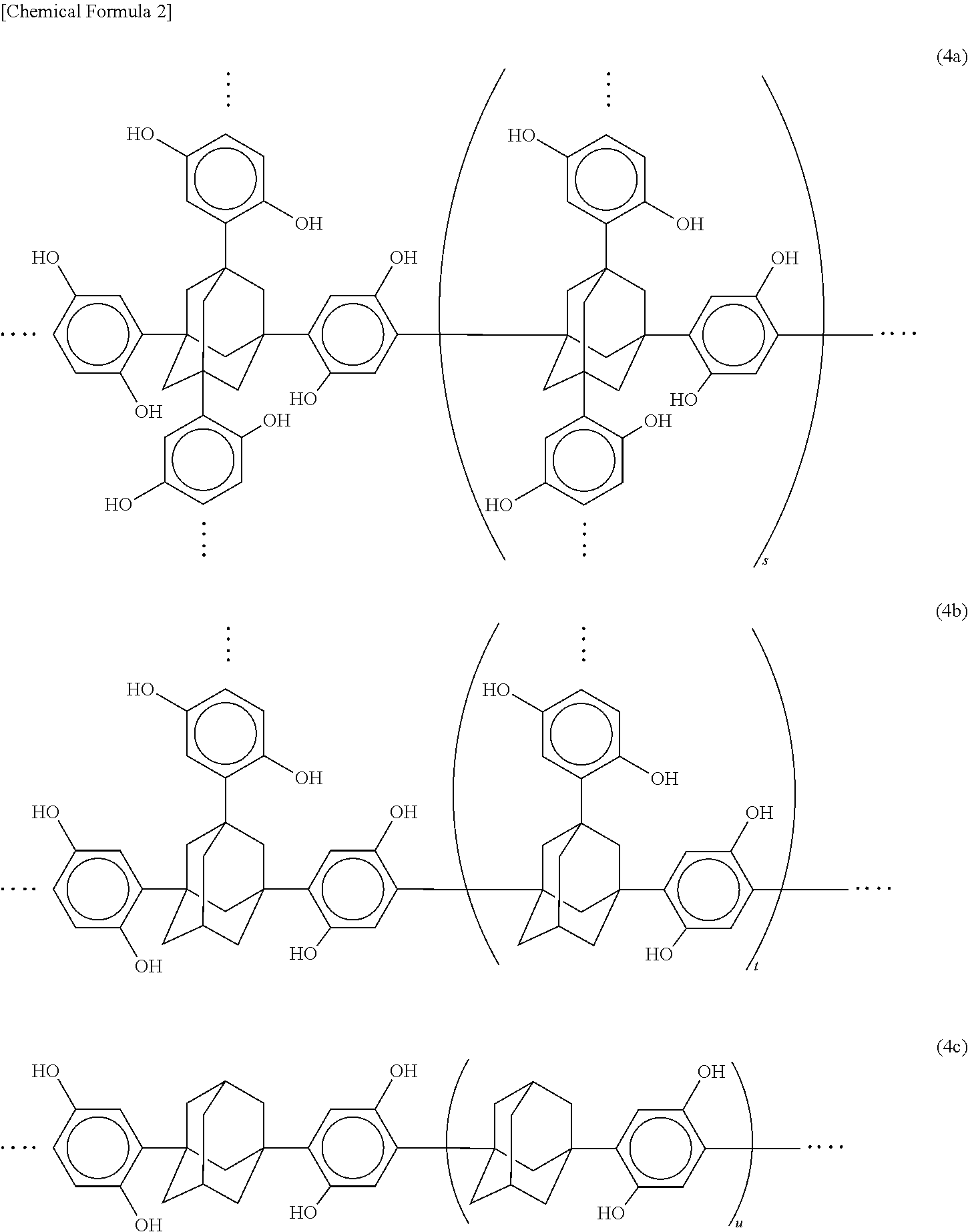Polyol compound for photoresist
- Summary
- Abstract
- Description
- Claims
- Application Information
AI Technical Summary
Benefits of technology
Problems solved by technology
Method used
Image
Examples
example 1
In a 200-mL three-necked flask equipped with a Dimroth condenser, a thermometer, and a stirring bar were placed 2.18 g of 1,3,5-adamantanetriol, 7.82 g of hydroquinone, 13.51 g of p-toluenesulfonic acid, and 56.67 g of n-butyl acetate, followed by stirring thoroughly. Next, the flask was purged with nitrogen and submerged in an oil bath heated to 140° C., to start heating with stirring. After being kept heating under reflux for 2 hours, the flask was cooled.
The cooled reaction solution was transferred from the flask to a separatory funnel, washed with 80 g of distilled water, and further washed with five portions of 65 g of distilled water. The washed reaction solution had a weight of 55.4 g. The washed reaction solution was poured into 500 g of n-heptane, to deposit orange fine particles. The fine particles were collected through filtration, dried at 60° C. for 12 hours, and thereby yielded 5.8 g of a polyol compound 1 for photoresists. The obtained polyol compound 1 for photoresis...
example 2
In a 200-mL three-necked flask equipped with a Dimroth condenser, a thermometer, and a stirring bar were placed 0.739 g of 1,3,5-adamantanetriol, 3.98 g of hydroquinone, 18.01 g of p-toluenesulfonic acid, and 18.01 g of n-butyl acetate, followed by stirring thoroughly. Next, the flask was purged with nitrogen and submerged in an oil bath heated to 140° C., to start heating with stirring. After being kept heating under reflux for 2 hours, the flask was cooled.
The cooled reaction solution was transferred from the flask to a separatory funnel and washed with six portions of 20 g of distilled water. The washed reaction solution had a weight of 15.6 g. The washed reaction solution was poured into 100 g of n-heptane, to deposit orange fine particles. The fine particles were collected through filtration, dried at 60° C. for 12 hours, and thereby yielded 2.2 g of a polyol compound 2 for photoresists. The obtained polyol compound 2 for photoresists was subjected to a GPC measurement and foun...
example 3
In a 200-mL three-necked flask equipped with a Dimroth condenser, a thermometer, and a stirring bar were placed 2.18 g of 1,3,5-adamantanetriol, 7.82 g of hydroquinone, 13.51 g of p-toluenesulfonic acid, and 56.67 g of n-butyl acetate, followed by stirring thoroughly. Next, the flask was purged with nitrogen and submerged in an oil bath heated to 100° C. to start heating with stirring. After being kept heating under reflux for 2 hours, the flask was cooled.
The cooled reaction solution was transferred from the flask to a separatory funnel, washed with 80 g of distilled water, and further washed with five portions of 65 g of distilled water. The washed reaction solution had a weight of 55.4 g. The washed reaction solution was poured into 500 g of n-heptane, to deposit orange fine particles. The fine particles were collected through filtration, dried at 60° C. for 12 hours, and thereby yielded 5.2 g of a polyol compound 3 for photoresists. The obtained polyol compound 3 for photoresist...
PUM
| Property | Measurement | Unit |
|---|---|---|
| Electrical resistance | aaaaa | aaaaa |
| Molecular weight | aaaaa | aaaaa |
| Hydrophobicity | aaaaa | aaaaa |
Abstract
Description
Claims
Application Information
 Login to View More
Login to View More - R&D Engineer
- R&D Manager
- IP Professional
- Industry Leading Data Capabilities
- Powerful AI technology
- Patent DNA Extraction
Browse by: Latest US Patents, China's latest patents, Technical Efficacy Thesaurus, Application Domain, Technology Topic, Popular Technical Reports.
© 2024 PatSnap. All rights reserved.Legal|Privacy policy|Modern Slavery Act Transparency Statement|Sitemap|About US| Contact US: help@patsnap.com










